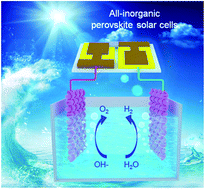Highly efficient overall water splitting driven by all-inorganic perovskite solar cells and promoted by bifunctional bimetallic phosphide nanowire arrays†
Abstract
Overall water splitting driven by a sustainable solar energy source has been recognized as a promising route to produce clean and renewable hydrogen fuel. However, its practical application is restricted by the low energy conversion efficiency and poor stability of photocatalysts. Herein, we report the realization of highly efficient overall water splitting promoted by bifunctional bimetallic phosphide (Ni0.5Co0.5P) nanowire arrays vertically grown on carbon paper (Ni0.5Co0.5P/CP) and driven by highly stable all-inorganic perovskite solar cells (PSCs). The Ni0.5Co0.5P/CP electrocatalysts can provide abundant active sites, high electrical conductivity, and good contact interface with the electrolyte, thus showing remarkable activity and great durability for both the hydrogen evolution reaction (HER) and oxygen evolution reaction (OER). The electrolyzer assembled with both the Ni0.5Co0.5P/CP anode and cathode can afford a current density of 10 mA cm−2 at only 1.61 V and allow consecutive water splitting. The all-inorganic PSCs based on a CsPb0.9Sn0.1IBr2 light absorber and a nanocarbon electrode exhibit remarkable stability. When driven by all-inorganic PSCs, the electrolyzer delivers a high overall energy conversion efficiency (3.12%) and good long-term durability.



 Please wait while we load your content...
Please wait while we load your content...